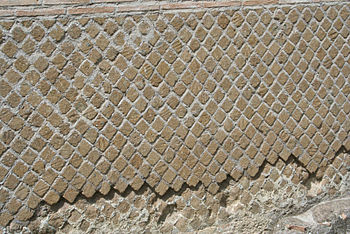Opus reticulatum

Opus reticulatum used on the exterior wall of Hadrian's Villa, which was used as a retreat for the Roman Emperor Hadrian in the early 2nd century.

Opus reticulatum in Pompeii
Opus reticulatum (also known as reticulated work) is a form of brickwork used in ancient Roman architecture. It consists of diamond-shaped bricks of tuff, referred to as cubilia,[1] placed around a core of opus caementicium.[2]
Contents
1 Overview
2 See also
3 References
4 External links
Overview
The diamond-shaped tufa blocks were placed with the pointed ends into the cement core at an angle of roughly 45 degrees, so the square bases formed a diagonal pattern, and the pattern of mortar lines resembled a net. Reticulatum is the Latin term for net-like, and opus, the term for a work of art, so the term translates to "net work".
This construction technique was used from the beginning of the 1st century BC, and remained very common until opus latericium, a different form of brickwork, became more common.[2] Examples have even been found in Etruscan cities, such as Rusellae, wherein opus reticulatum is present around the entire perimeter of the Roman amphitheater. In the Roman province of Judea, Herod The Great used such brickwork in the baths of his 3rd Palace of the larger Hasmonean royal winter palaces complex in Jericho.
Opus reticulatum was used as a technique in the Renaissance Palazzo Rucellai in Florence, the skill having been lost with the end of the Roman Empire, and rediscovered by means of archeology by Leon Battista Alberti.
The initial, rough form of opus reticulatum, an advancement from opus incertum, is called opus quasi reticulatum.
See also
Opus quadratum – Roman masonry using parallel courses of squared stone of the same height
Opus incertum – Ancient Roman masonry using irregular stones in a core of concrete
Opus mixtum, also known as Opus compositum – Combination of Roman constuction techniques
Roman concrete, also known as Opus caementicium – Building material used in construction during the late Roman Republic and Empire
References
^ http://www.vitruvius.be/boek2h8.htm
^ ab Roth, Leland M. (1993). Understanding Architecture: Its Elements, History and Meaning (First ed.). Boulder, CO: Westview Press. p. 222. ISBN 0-06-430158-3..mw-parser-output cite.citationfont-style:inherit.mw-parser-output qquotes:"""""""'""'".mw-parser-output code.cs1-codecolor:inherit;background:inherit;border:inherit;padding:inherit.mw-parser-output .cs1-lock-free abackground:url("//upload.wikimedia.org/wikipedia/commons/thumb/6/65/Lock-green.svg/9px-Lock-green.svg.png")no-repeat;background-position:right .1em center.mw-parser-output .cs1-lock-limited a,.mw-parser-output .cs1-lock-registration abackground:url("//upload.wikimedia.org/wikipedia/commons/thumb/d/d6/Lock-gray-alt-2.svg/9px-Lock-gray-alt-2.svg.png")no-repeat;background-position:right .1em center.mw-parser-output .cs1-lock-subscription abackground:url("//upload.wikimedia.org/wikipedia/commons/thumb/a/aa/Lock-red-alt-2.svg/9px-Lock-red-alt-2.svg.png")no-repeat;background-position:right .1em center.mw-parser-output .cs1-subscription,.mw-parser-output .cs1-registrationcolor:#555.mw-parser-output .cs1-subscription span,.mw-parser-output .cs1-registration spanborder-bottom:1px dotted;cursor:help.mw-parser-output .cs1-hidden-errordisplay:none;font-size:100%.mw-parser-output .cs1-visible-errorfont-size:100%.mw-parser-output .cs1-subscription,.mw-parser-output .cs1-registration,.mw-parser-output .cs1-formatfont-size:95%.mw-parser-output .cs1-kern-left,.mw-parser-output .cs1-kern-wl-leftpadding-left:0.2em.mw-parser-output .cs1-kern-right,.mw-parser-output .cs1-kern-wl-rightpadding-right:0.2em
External links
| Wikimedia Commons has media related to Opus reticulatum. |
- Sample images
This architecture-related article is a stub. You can help Wikipedia by expanding it. |
